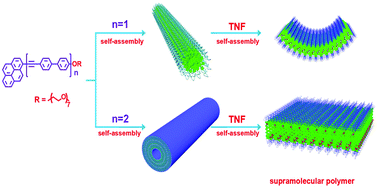Our official English website, www.x-mol.net, welcomes your
feedback! (Note: you will need to create a separate account there.)
Donor–acceptor interaction-driven self-assembly of amphiphilic rod–coil molecules into supramolecular nanoassemblies
Nanoscale ( IF 5.8 ) Pub Date : 2017-10-25 00:00:00 , DOI: 10.1039/c7nr05329k Shengsheng Yu 1, 2, 3, 4, 5 , Yuntian Yang 1, 2, 3, 4, 5 , Tie Chen 1, 2, 3, 4, 5 , Jingzhe Xu 1, 2, 3, 4, 5 , Long Yi Jin 1, 2, 3, 4, 5
Nanoscale ( IF 5.8 ) Pub Date : 2017-10-25 00:00:00 , DOI: 10.1039/c7nr05329k Shengsheng Yu 1, 2, 3, 4, 5 , Yuntian Yang 1, 2, 3, 4, 5 , Tie Chen 1, 2, 3, 4, 5 , Jingzhe Xu 1, 2, 3, 4, 5 , Long Yi Jin 1, 2, 3, 4, 5
Affiliation

|
Rigid–flexible amphiphilic molecules consisting of an aromatic segment based on pyrene and biphenyl units and hydrophilic polyethylene oxide chains self-assemble into lamellar, hexagonal columnar, and two-dimensional columnar nanostructures in the bulk state. In aqueous solution, these molecules self-assemble into nanofibers, spherical micelles, and multilayer nanotubes, depending on the chain or rod length of the molecules. Notably, ordered nanostructures of supramolecular polymers, such as single-layer curving fragments, nanofibers, and nanosheets, were constructed through charge-transfer interactions between the nanoobjects and an electron-acceptor molecule, 2,4,5,7-tetranitrofluorenone. These experimental results reveal that diverse supramolecular morphologies can be controlled by tuning rod–coil molecular interactions or charge-transfer interactions between the donor and acceptor molecules.
中文翻译:

供体-受体相互作用驱动两亲杆-线圈分子自组装成超分子纳米组装体
由基于flex和联苯单元的芳族链段和亲水性聚环氧乙烷链组成的刚性柔韧性两亲分子在堆积状态下自组装成层状,六边形柱状和二维柱状纳米结构。在水溶液中,取决于分子的链或棒长度,这些分子会自组装成纳米纤维,球形胶束和多层纳米管。值得注意的是,超分子聚合物的有序纳米结构,例如单层弯曲片段,纳米纤维和纳米片,是通过纳米物体与电子受体分子2,4,5,7-四硝基芴酮之间的电荷转移相互作用而构建的。
更新日期:2017-11-23
中文翻译:

供体-受体相互作用驱动两亲杆-线圈分子自组装成超分子纳米组装体
由基于flex和联苯单元的芳族链段和亲水性聚环氧乙烷链组成的刚性柔韧性两亲分子在堆积状态下自组装成层状,六边形柱状和二维柱状纳米结构。在水溶液中,取决于分子的链或棒长度,这些分子会自组装成纳米纤维,球形胶束和多层纳米管。值得注意的是,超分子聚合物的有序纳米结构,例如单层弯曲片段,纳米纤维和纳米片,是通过纳米物体与电子受体分子2,4,5,7-四硝基芴酮之间的电荷转移相互作用而构建的。











































 京公网安备 11010802027423号
京公网安备 11010802027423号